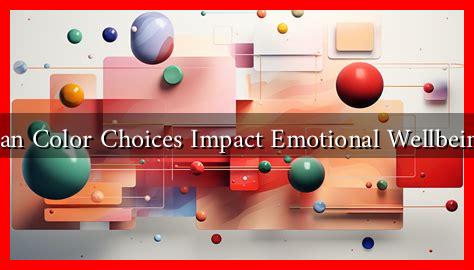-
Table of Contents
Can Color Choices Impact Emotional Wellbeing?
Color is an integral part of our daily lives, influencing our moods, perceptions, and even behaviors. From the clothes we wear to the environments we inhabit, color choices can significantly impact our emotional wellbeing. This article explores the psychological effects of color, how different hues can evoke specific emotions, and practical applications for enhancing wellbeing through color.
The Psychology of Color
Color psychology is a field that studies how colors affect human behavior and emotions. Various studies have shown that colors can evoke specific feelings and reactions. For instance, warm colors like red and orange are often associated with energy and passion, while cool colors like blue and green tend to promote calmness and relaxation.
Common Color Associations
- Red: Often linked to excitement, passion, and urgency. It can increase heart rates and stimulate appetite, which is why many restaurants use red in their decor.
- Blue: Associated with tranquility and stability. Studies have shown that blue can lower heart rates and reduce feelings of anxiety.
- Yellow: Represents happiness and optimism. However, excessive yellow can lead to feelings of frustration or anger.
- Green: Symbolizes nature and growth. It is known to have a calming effect and can help reduce stress.
- Purple: Often linked to creativity and luxury. It can inspire imagination and is frequently used in artistic settings.
Scientific Evidence Supporting Color’s Impact on Emotions
Numerous studies have explored the relationship between color and emotional wellbeing. For example, a study published in the journal “Color Research and Application” found that individuals exposed to blue light reported lower levels of stress and anxiety compared to those in environments with red light. Another research conducted by the University of British Columbia indicated that participants in a green environment experienced improved cognitive function and mood.
Moreover, a survey by the Institute for Color Research revealed that people make a subconscious judgment about a person, environment, or product within 90 seconds of initial viewing, with 62-90% of that assessment based solely on color. This highlights the profound impact color can have on our perceptions and emotional responses.
Practical Applications of Color in Daily Life
Understanding the emotional implications of color can help individuals make informed choices in various aspects of their lives. Here are some practical applications:
- Home Decor: Choosing calming colors like soft blues and greens for bedrooms can promote relaxation and better sleep.
- Workspaces: Incorporating vibrant colors like yellow or orange in creative spaces can stimulate innovation and productivity.
- Clothing Choices: Wearing colors that resonate with your mood can enhance self-esteem and confidence. For instance, wearing red can boost energy levels before a big presentation.
- Art Therapy: Art therapists often use color as a tool for expression and healing, allowing clients to explore their emotions through color choices.
Case Studies and Real-Life Examples
Several organizations have successfully utilized color psychology to enhance emotional wellbeing. For instance, the interior design of hospitals has increasingly incorporated soothing colors to create a healing environment. A study at the University of Michigan found that patients in rooms painted with soft colors experienced less pain and anxiety during recovery.
Additionally, companies like Google and Apple have employed color psychology in their branding and product design to evoke specific emotions and create a positive user experience. Their use of color not only attracts customers but also fosters a sense of trust and reliability.
Conclusion
Color choices play a significant role in shaping our emotional wellbeing. By understanding the psychological effects of different colors, individuals can make informed decisions that enhance their mood, reduce stress, and promote overall mental health. Whether through home decor, clothing, or workplace design, the strategic use of color can lead to a more fulfilling and emotionally balanced life.
As we continue to explore the intricate relationship between color and emotion, it becomes clear that our choices in color are not merely aesthetic but deeply intertwined with our psychological state. For further reading on color psychology, you can visit Color Psychology.


